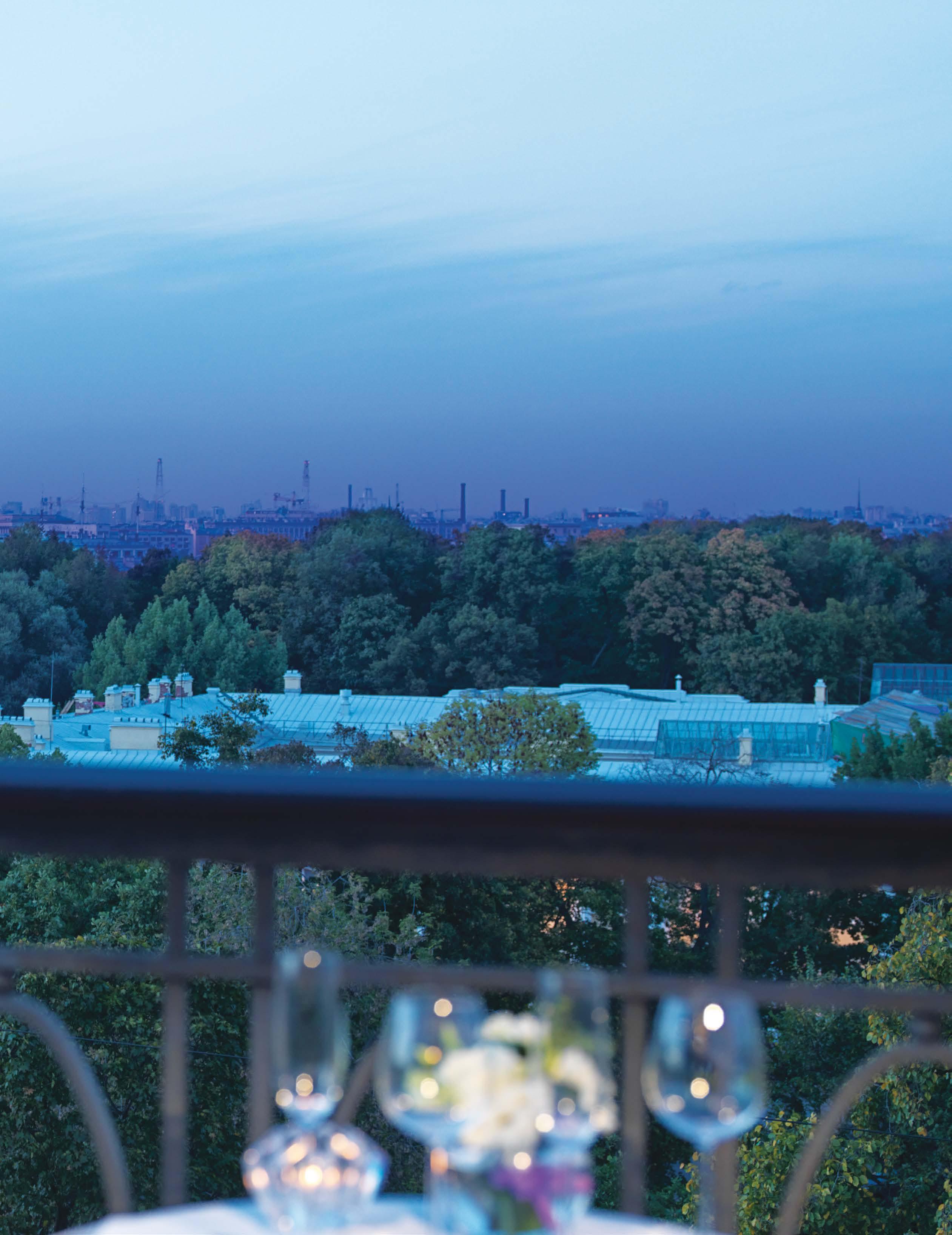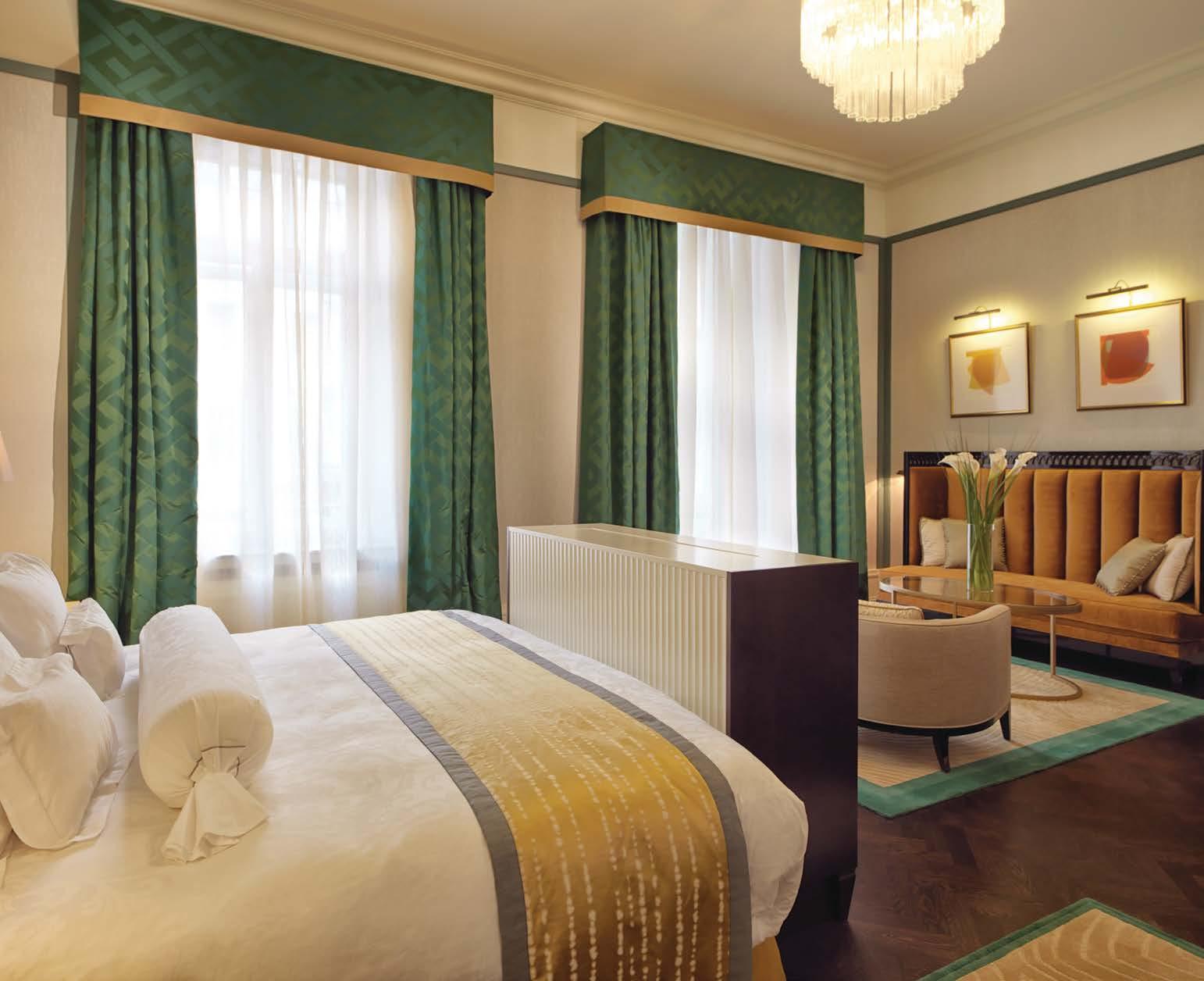
8 minute read
FROM RUSSIA WITH LOVE
Written by Alexandra Sharova

I’ve always wanted to travel back in time, not to change anything, but to experience another era, a world that can only be read about in books. Going to St.Petersburg—once the capital of Imperial Russia—is as close to time travel as one can get. The city is overflowing with history, seen in its largely preserved architecture dating back to the 19th century, and the art culture it holds within multi-colored walls encased in meringue moldings. With an array of styles, from Neoclassical to Baroque, and everything erected pre-and-post-Soviet rule, it’s a dream for an accelerated two-day deep dive into the city’s heritage.

To experience the Russia of Tchaikovsky, Dostoevsky, and Pushkin in all its glory I took a solo adventure to the Belmond Grand Hotel Europe, right in the heart of the city. No place is better suited for soaking in the splendor and spirit of St. Petersburg than a hotel that’s more like a living, breathing part of the local story. Like the city itself, it has undergone tremendous changes to fit an everevolving socio-political climate, since its opening in 1875. Even back then, it was at the vanguard of innovation and style; boasting the first restaurant with electric lights, which drew in nobility and artists to its lavish Hall, where a stained-glass mural of Apollo served as the backdrop for countless ballets, operas, and even Rasputin’s secret meetings.
A delayed flight from Moscow cut my first day of exploring in half, but nothing was going to stop me from rediscovering the city I visited as a child. I conveniently arrive at sunset to the Art Nouveau decorated hotel, and my butler—yes, butler!—guides me to a themed suite that honors Fabergé, the locally founded jewelry company whose illustrious jewel-encrusted eggs stand in a class of art all on their own. Just like the intricately adorned pieces, the suite is drenched in opulent, jewel-toned details: gold-accented wallpaper, a plush velvet chaise, Fabergé egg paintings, and a mahogany desk equipped with custom stationery, that makes my inner-writer light up with uncontrollable glee. I feel as though I’ve transformed into a member of Russia’s aristocracy.
I walk out onto Nevsky Prospekt and though the evening air is brisk, the city is scintillating in a bevy of warm lights. Strolling towards the historic Anichkov Bridge, which happens to be the oldest in the city, I find myself mesmerized by the incredible mélange of periods towering before me in pastel hues. My daze is interrupted by an explosion...fireworks are bursting into a thousand scarlet smithereens, miniature flames burning over the
72 | MARCH/APRIL 2020 Fontanka River. Although St. Petersburg was likely to join my growing list of favorite cities, the chance performance solidified its place in spite of my Moscow roots. Passing by the Church of Saint Catherine, the Kazan Cathedral, and Gostiny Dvor (all on my “to see” list in tomorrow's daylight), makes me appreciate the central location of my hotel because the river’s breeze is piercing through my leather jacket, making a bar pitstop inevitable. I opt for an intimate spot recommended by a young local couple, Apotheke (a play on apothecary, due to the serious mixology that goes on inside). The vibe is a cross between the 1920s and Brooklyn hipster—befitting the journey-through-time theme of my weekend—and a stark contrast to the neighboring dive bars. A dapper bartender (equipped with a mustache that could make Salvadore Dali roll over in his grave) explains that the slogan here is “think what you drink,” meaning there’s no menu, just surprises with minimal direction. My bespoke cocktail features fresh blackberries and a tart kick within a gin concoction, presented in fine crystal. It’s everything I didn’t know I needed in a nightcap.
Since time is limited and St. Petersburg is overflowing with places to see, I rise bright and early for a traditional Russian breakfast at the hotel. In keeping with stereotypes (and historical accuracy), I enjoy blini with a generous caviar spread, and one too many pastries with an array of wild berry jams. I arrive at Saint Isaac’s Cathedral, just as the sun pours over its 70-foot gold-leaf covered colossus of a dome. The Cathedral is imposing, with its marble pillars, nearly blinding palatial interior, and the world’s heaviest Foucault pendulum that was added when the space was transformed into a museum in 1931. Though the murals and icons are marvelous, the 365 degree view of the city from the colonnade, takes my breath away (as did the 262 steps I conquered to revel in the scene). With a cappuccino in hand I walk to my next stop, the Russian State Museum.
The museum, which houses the world’s largest collection of Russian art, is a former palace. Its muted-yellow exterior and Empirical design are quintessential to the region’s style in the 1830s, and a pleasant contrast from the classic beige and cream tones I had grown accustomed to during my travels across Europe. Though my time is limited, and most halls have to be observed with high-speed scans, a few pieces stop me in my tracks. The “Knight at the Crossroads,” depicting a mournful man atop his faithful steed with ominous symbols (scattered bones and a black raven flying overhead), reminds the viewer of the country’s solemn history of war and the many lives lost in honorable battles. Ivan Aivazovsky’s “The Shipwreck,” with a tumultuous sea and Romantic portrayal of daybreak, also made its way into my long list of loved artworks.

Leaving in an art-overloaded daze, I grab an Uber—which are thankfully accessible around the city—to see one of the city’s main attractions, the Church of the Savior on Spilled Blood (dedicated to Tsar Alexander II), before it closes for the day. Sadly, the line is weaving around the block. Pro tip: arrive in advance for a chance to marvel at the out-of-this-world turquoise vibrancy and shimmering gold mosaics that span an astounding 75,000 square feet inside the church. The dome-shaped exterior is reminiscent of a fairytale castle due to kaleidoscopic patterns whose brilliance pops against the fading sky. Walking away from the crowd I stop before a local punk band singing a song about Leningrad— the city’s name between 1924 and 1991. Just another reminder of how much history this beautiful city holds. I arrive at my last sight of the day, the Fabergé Museum, as the sun rolls beyond the Fontanka River. Inside, everything is dazzling. Diamonds, rubies, pearls, and emeralds cover miniature clocks, picture frames, hairbrushes and a slew of other accessories, and of course the prized Easter Eggs collection, created for the last two emperors. The eggs are aweinspiring; crafted with unparalleled mastery, each intricate detail contributes a themed fantasy. I nearly cave and purchase a replica in the gift shop, but luckily it dawns on me that I am only living like “royalty” for one more night…
Back in my suite I indulge in a few truffles from the hotel’s very own chocolate factory before heading down to Tchaikovsky Night at L’Europe. Set in the country’s oldest continually serving restaurant, the evening honors the composer whose ballets have been showing in St. Petersburg since 1895. While a String Ensemble plays heavenly melodies I enjoy the Egg in Egg: a truffle-meetscaviar delight befitting a Tsar. Sticking to Russian dishes, I get a Kamchatka Crab Salad that mingles molecular gastronomy trends with a traditional recipe. It’s delicious thanks to an unexpected basil foam, which provides a refreshing mousse texture to a typically mayonnaise-heavy starter. The performance switches to opera, and between the close proximity to the stage and the powerful tenor, I feel a chill run through me. As the aromatic Duck Supreme arrives in all its seasonal-berry drenched glory, the first duet from the famed Swan Lake begins. The duo is enchanting, and their every move has me smiling from ear-to-ear with nostalgia for my childhood trips to the Bolshoi Theatre in Moscow. It truly feels as though I’ve been transported to another time, reliving an evening from the 19th century.

After last night’s magical evening I’m dreading leaving the hotel, but the renowned State Hermitage Museum, whose Winter Palace complex once housed the Romanov family, is on the agenda. Given that I have but a few hours before my flight and the museum astonishingly houses over three-million items in its collection, I get an audio tour and nearly sprint up the winding, velvet-lined staircase. Keep in mind, the museum is in the ranks with the Louvre and the MET, so it’s busy—people waiting for hours to get in, busy. With the help of a map and my handy guide I manage to see a decent amount of my favorite periods, like The Romantics, Impressionists, and plenty of lavish furniture that belonged to the royal family, but it’s clear that a return in the hopefully near future is imperative. With art, history, and an incredibly rich cultural experience all replaying in my mind, I head to the airport. It almost feels like I’m set to return to modern times from a vacation in another world, another time. Regardless of my Moscow background, Russian roots run deep...I feel an inexplicable pull towards St.Petersburg: like it’s a version of home. *










